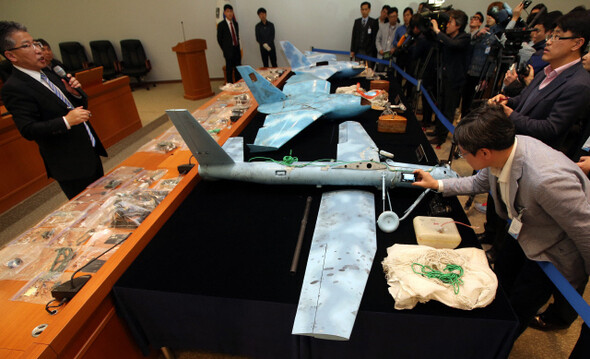hankyoreh
Links to other country sites 다른 나라 사이트 링크
Crashed drones believed to be from North Korea

By Park Byong-su, senior staff writer
Short-range transmission chips in the small drones found crashed in Paju and other sites recently had their manufacturer names and model numbers erased, investigation findings show.
The Ministry of National Defense believes the information was deliberately removed by North Korea to conceal the frequency band receiving transmissions from the unmanned aerial vehicles (UAVs).
The MND announced interim findings on Apr. 11 from its central joint investigation team’s investigation into three small drones found crashed in Paju and Samcheok and on Baengnyeong Island. According to the ministry, the investigation turned up “significant circumstantial evidence of North Korea’s responsibility.”
In addition to the removal of chip model numbers, other evidence included the heavy concentration of military facilities in the drones’ flight path, the fact that the UAV specifications did not match models used in South Korea, the 180km to 300km flight ranges that would seem to rule out Chinese or Japanese responsibility, and the failure to match six fingerprints from the drones to any domestically registered data.
Despite the circumstantial evidence, no direct evidence was provided. Kim Jong-seong, head of UAV systems development for the Agency for Defense Development and the leader of the investigation, explained that additional analysis would need to focus on the memory containing data input to direct the flight path.
“That could take anywhere from two weeks to another month,” he added.
The UAVs were confirmed to have parts from six countries: South Korea, the US, Japan, China, the Czech Republic, and Switzerland. South Korean-made components included 4M DRAM from Samsung Electronics and a Hitec RCD servo motor.
“The engines, GPS receivers, gyro centers, and cameras were mostly things you can find pretty easily on the market,” said a military official on condition of anonymity.
Sources also reported that five of the photographs taken by the drones were images of the Blue House, although the investigation team noted that the photographs in question were not transmitted to North Korea.
“The UAVs had low-output analog image transmitters attached, but these are systems for the sending information back to the ground to confirm that everything’s functioning properly once the drone is up in the air,” said one source on condition of anonymity. “These are transmission distances in the range of just a few kilometers.”
The team concluded that the UAV technology was roughly on par with South Korea’s level in the early 2000s. Kim Jong-seong noted a case in 2008 when South Korean graduate students developed a small drone that made a round trip between Uljin, North Gyeongsang Province, and Dokdo.
But the drone found on Baengnyeong Island was also deemed to be more technologically advanced than the ones discovered in Paju and Samcheok.
“The central processing unit and other components were all newer, and with the flight attitude controls there were technological improvements in acceleration and gyro sensors,” Kim said. “This would have allowed for more precise controlling.”
Analysis of filming times showed that the Paju drone began taking pictures near Paju City Hall at 10:03 am on Mar. 24. It traveled southeast from there, reaching the skies over Seoul City Hall by 10:16 am before making a U-turn northwest. It crashed into a hill in Paju around two minutes after taking its last picture at about 10:28 am.
The Baengnyeong drone was found to have started taking pictures at 2:02 pm on Mar. 31, traveling in an S-shaped path by Socheong and Daecheong Islands before crashing into Baengnyeong Island at about 4 pm.
The Paju and Samcheok drones had two-stroke glow engines using a mixture of methyl alcohol and lubricating oil, while the Baengnyeong drone had a gasoline-powered four-stroke engine.
Please direct questions or comments to [english@hani.co.kr]

Editorial・opinion
![[Column] Has Korea, too, crossed the Rubicon on China? [Column] Has Korea, too, crossed the Rubicon on China?](https://flexible.img.hani.co.kr/flexible/normal/500/300/imgdb/original/2024/0419/9317135153409185.jpg) [Column] Has Korea, too, crossed the Rubicon on China?
[Column] Has Korea, too, crossed the Rubicon on China?![[Correspondent’s column] In Japan’s alliance with US, echoes of its past alliances with UK [Correspondent’s column] In Japan’s alliance with US, echoes of its past alliances with UK](https://flexible.img.hani.co.kr/flexible/normal/500/300/imgdb/original/2024/0419/2317135166563519.jpg) [Correspondent’s column] In Japan’s alliance with US, echoes of its past alliances with UK
[Correspondent’s column] In Japan’s alliance with US, echoes of its past alliances with UK- [Editorial] Does Yoon think the Korean public is wrong?
- [Editorial] As it bolsters its alliance with US, Japan must be accountable for past
- [Guest essay] Amending the Constitution is Yoon’s key to leaving office in public’s good graces
- [Editorial] 10 years on, lessons of Sewol tragedy must never be forgotten
- [Column] A death blow to Korea’s prosecutor politics
- [Correspondent’s column] The US and the end of Japanese pacifism
- [Guest essay] How Korea turned its trainee doctors into monsters
- [Guest essay] As someone who helped forge Seoul-Moscow ties, their status today troubles me
Most viewed articles
- 1[Column] The clock is ticking for Korea’s first lady
- 2Samsung barricades office as unionized workers strike for better conditions
- 3After 2 months of delayed, denied medical care, Koreans worry worst may be yet to come
- 4[Correspondent’s column] In Japan’s alliance with US, echoes of its past alliances with UK
- 5[Column] Has Korea, too, crossed the Rubicon on China?
- 6Hong Se-hwa, voice for tolerance whose memoir of exile touched a chord, dies at 76
- 7[Editorial] When the choice is kids or career, Korea will never overcome birth rate woes
- 8Constitutional Court rules to disband left-wing Unified Progressive Party
- 9Nearly 1 in 5 N. Korean defectors say they regret coming to S. Korea
- 10‘Right direction’: After judgment day from voters, Yoon shrugs off calls for change